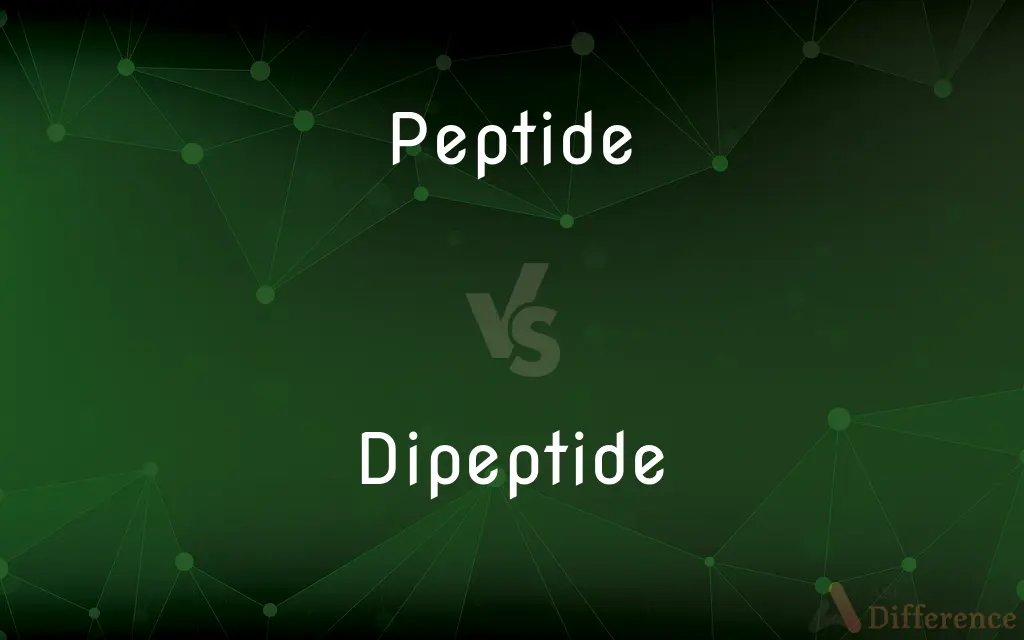Peptide vs. Dipeptide — What's the Difference?
Edited by Tayyaba Rehman — By Fiza Rafique — Updated on September 27, 2023
A peptide is a molecule consisting of two or more amino acids linked by peptide bonds. A dipeptide is a specific type of peptide formed by two amino acids.

Difference Between Peptide and Dipeptide
Table of Contents
ADVERTISEMENT
Key Differences
A peptide is a biological molecule made up of amino acids linked together through peptide bonds. On the other hand, a dipeptide is a particular type of peptide which contains just two amino acids joined together.
The term "peptide" can refer to any molecule formed by joining amino acids, regardless of its length. A dipeptide, as its name suggests, specifically denotes a peptide with only two amino acids. Therefore, all dipeptides are peptides, but not all peptides are dipeptides.
Peptides play vital roles in biological processes and can range from small molecules like dipeptides to large complex molecules. Dipeptides, being the simplest peptides, are often building blocks or intermediates in the synthesis and breakdown of larger peptides and proteins.
While the formation of a peptide requires a condensation reaction between the amino group of one amino acid and the carboxyl group of another, forming a dipeptide necessitates this reaction between just two amino acids. The resulting bond in both peptides and dipeptides is the peptide bond, which is a type of covalent bond.
Comparison Chart
Definition
Molecule formed by linking amino acids.
Peptide specifically made of two amino acids.
ADVERTISEMENT
Number of Amino Acids
Can be two or more.
Exactly two.
Complexity
Can range from simple to complex.
Always simple, as it's made of only two amino acids.
Examples
Can include dipeptides, tripeptides, polypeptides.
Glycylglycine, alanylglycine.
Role
Various roles in biology including signaling and structure.
Often act as intermediates in peptide synthesis.
Compare with Definitions
Peptide
A short chain of amino acids, typically lacking a defined structure.
Certain peptides act as neurotransmitters in the brain.
Dipeptide
A molecule consisting of two amino acids joined by a single peptide bond.
Aspartame, an artificial sweetener, is a dipeptide.
Peptide
A biological molecule smaller than a protein.
Some skincare products contain peptides to promote skin health.
Dipeptide
A peptide formed by two amino acids.
Carnosine is a dipeptide found in muscle tissue.
Peptide
A molecule composed of amino acids linked by peptide bonds.
Insulin is a peptide hormone that regulates blood sugar.
Dipeptide
A short chain of exactly two amino acids.
The dipeptide bonds in proteins are hydrolyzed during digestion.
Peptide
A compound resulting from the condensation of two or more amino acids.
Collagen is a peptide that provides structural support in the skin.
Dipeptide
A compound formed by the dehydration synthesis of two amino molecules.
Glycylglycine is a common dipeptide used in laboratory studies.
Peptide
A chain of amino acids that can function in various biological activities.
Peptides play a crucial role in cellular signaling.
Dipeptide
The simplest form of peptides with only two constituent amino acids.
The breakdown of proteins can produce dipeptides.
Peptide
Peptides (from Greek language πεπτός, peptós "digested"; derived from πέσσειν, péssein "to digest") are short chains of between two and fifty amino acids, linked by peptide bonds. Chains of fewer than ten or fifteen amino acids are called oligopeptides, and include dipeptides, tripeptides, and tetrapeptides.
Dipeptide
A dipeptide is an organic compound derived from two amino acids. The constituent amino acids can be the same or different.
Peptide
Any of various natural or synthetic compounds containing two or more amino acids joined by peptide bonds that link the carboxyl group of one amino acid to the amino group of another.
Dipeptide
A peptide that is composed of two amino acid molecules linked by a peptide bond.
Peptide
(organic compound) Any of a class of organic compounds consisting of various numbers of amino acids in which the amine of one is reacted with the carboxylic acid of the next to form an amide bond.
Dipeptide
An organic compound formed from two amino acids joined by a peptide bond.
Peptide
(chemistry) The peptide bond itself.
Peptide
Amide combining the amino group of one amino acid with the carboxyl group of another; usually obtained by partial hydrolysis of protein
Common Curiosities
Is a dipeptide the smallest peptide?
Yes, dipeptides are the simplest form of peptides with only two amino acids.
Are proteins and peptides the same?
No, proteins are larger and more complex than peptides.
Are all dipeptides also peptides?
Yes, all dipeptides are peptides, but not all peptides are dipeptides.
Is a dipeptide longer than a tripeptide?
No, a dipeptide has two amino acids while a tripeptide has three.
What bond holds amino acids in a peptide together?
Amino acids in a peptide are held together by peptide bonds.
Do peptides have roles in skincare?
Yes, some peptides are used in skincare products for their beneficial effects.
Are peptides only found in humans?
No, peptides are found across various organisms, not just in humans.
How many amino acids are in a peptide?
A peptide can have two or more amino acids.
How many amino acids are in a dipeptide?
A dipeptide consists of exactly two amino acids.
Can dipeptides act as intermediates in biochemical reactions?
Yes, dipeptides often act as intermediates in peptide synthesis and breakdown.
Are dipeptides used in any commercial products?
Yes, for example, aspartame, an artificial sweetener, is a dipeptide.
Do peptides play roles in cellular signaling?
Yes, some peptides are involved in cellular signaling processes.
How is a dipeptide formed?
A dipeptide is formed by the condensation of two amino acids.
Can dipeptides be found in food?
Yes, dipeptides can be present in food as a result of protein breakdown.
Are the properties of a peptide determined by its amino acid sequence?
Yes, the sequence and nature of amino acids in a peptide determine its properties.
Share Your Discovery

Previous Comparison
Rakija vs. Raki
Next Comparison
Demonstrable vs. DemonstrationAuthor Spotlight
Written by
Fiza RafiqueFiza Rafique is a skilled content writer at AskDifference.com, where she meticulously refines and enhances written pieces. Drawing from her vast editorial expertise, Fiza ensures clarity, accuracy, and precision in every article. Passionate about language, she continually seeks to elevate the quality of content for readers worldwide.
Edited by
Tayyaba RehmanTayyaba Rehman is a distinguished writer, currently serving as a primary contributor to askdifference.com. As a researcher in semantics and etymology, Tayyaba's passion for the complexity of languages and their distinctions has found a perfect home on the platform. Tayyaba delves into the intricacies of language, distinguishing between commonly confused words and phrases, thereby providing clarity for readers worldwide.














































